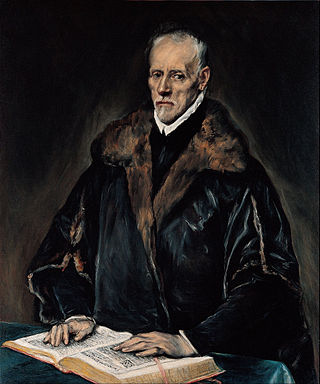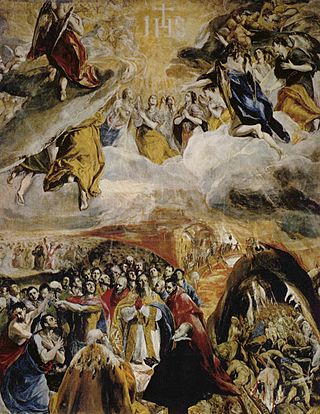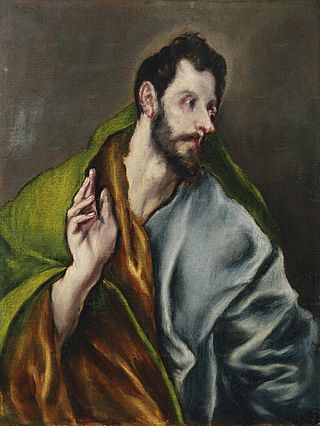
Doménikos Theotokópoulos, most widely known as El Greco, was a Greek painter, sculptor and architect of the Spanish Renaissance. El Greco was a nickname, and the artist normally signed his paintings with his full birth name in Greek letters often adding the word Κρής, which means "Cretan" in Ancient Greek.

Giorgio Giulio Clovio or Juraj Julije Klović was a Croatian-Italian illuminator, miniaturist, and painter born in the Kingdom of Croatia, who was mostly active in Renaissance Italy. He is considered the greatest illuminator of the Italian High Renaissance, and arguably the last very notable artist in the long tradition of the illuminated manuscript, before some modern revivals.

Museo di Capodimonte is an art museum located in the Palace of Capodimonte, a grand Bourbon palazzo in Naples, Italy designed by Giovanni Antonio Medrano. The museum is the prime repository of Neapolitan painting and decorative art, with several important works from other Italian schools of painting, and some important ancient Roman sculptures. It is one of the largest museums in Italy. The museum was inaugurated in 1957.

The Burial of the Count of Orgaz is a 1586 painting by El Greco, a prominent Renaissance painter, sculptor, and architect of Greek origin. Widely considered among his finest works, it illustrates a popular local legend of his time. An exceptionally large painting, it is divided into two sections, heavenly above and terrestrial below, but it gives little impression of duality, since the upper and lower sections are brought together compositionally.

Christ Driving the Money Changers from the Temple is a painting by El Greco, from 1568, now in the National Gallery of Art in Washington, D.C., in the United States. It depicts the Cleansing of the Temple, an event in the Life of Christ.

The Nobleman with his Hand on his Chest is an oil painting by El Greco, one of the earliest works painted by the artist in Spain.

Healing of the Man Born Blind is a c.1573 painting by El Greco, showing the healing the man blind from birth. It is now in the Galleria nazionale di Parma. It is signed at the bottom right-hand corner. It shows the artist returning to a theme he had first painted five years earlier, in a work now in Dresden.

Portrait of Giulio Clovio is a Renaissance era painting by El Greco c. 1571. It was commissioned by Italian cardinal Alessandro Farnese during the artist's stay in Rome. It formed part of the Farnese collection. Charles of Bourbon inherited it in 1734 and moved it to Naples, where it now hangs in the Museo di Capodimonte.

Portrait of Fernando Niño de Guevara is a 1600 painting of cardinal Fernando Niño de Guevara by El Greco, now in the Metropolitan Museum of Art in New York.

Self-Portrait or Portrait of an Old Man is an oil-on-canvas painting by El Greco, likely dating to between 1595 and 1600. The work's distinction as a self-portrait has been widely debated by scholars for over a century. Identification as a self portrait is supported by the idea that the same figure appears several times in El Greco's oeuvre, aging alongside the artist. Critics of this work's identification as a self-portrait point to a lack of evidence to positively identify it as such. It shows the influence of Titian and Tintoretto, whose works El Greco studied in Venice. It is currently in the Metropolitan Museum of Art in New York.

Portrait of Antonio de Covarrubias is a 1595-1600 oil on canvas painting by El Greco, dating to his time in Toledo. It is now in the Louvre in Paris as the result of an exchange with Spanish museums in 1941.

Portrait of Juan Pardo de Tavera is a 1609 oil on canvas painting by El Greco, now in the Hospital de Tavera in Toledo, founded by the portrait's subject. It was painted long after the 1545 death of its subject, cardinal Juan Pardo de Tavera, and so the artist modelled the cardinal's features on a funerary mask by Alonso Berruguete.

Portrait of Francisco de Pisa is a 1614 painting by El Greco, now in the Kimbell Art Museum in Fort Worth, Texas. Most art historians identify it as doctor Francisco de Pisa, a Spanish cleric, though a minority identify it as the Italian historian Giacomo Bosio due to the words shown in the open book. Francisco de Pisa was an enemy of Teresa of Ávila, who he criticised because he felt that her works contained "much that contradicts truth and sound doctrine and all good use of mental prayer". The pose of the subject is similar to that in Portrait of Cardinal Tavera, which is of a similar date.

Adoration of the Holy Name of Jesus is a 1577-1579 oil on canvas painting by El Greco, produced early in his Toledo period and now in exhibition at the Galerias Reales in Madrid. It is also known in modern scholarship as La Gloria, The Dream of Philip II or Allegory of the Holy League.

The Adoration of the Magi is an oil painting executed ca. 1565–1567 by El Greco. It and his St Luke Painting the Madonna and Child are his most western works, with Adoration showing the particularly strong influence of Parmigianino at this time in his career. It may have been painted in Venice or elsewhere during his stay in Italy or for an Italian client living in the painter's native Crete, but this is debated. It is now in the Benaki Museum in Athens.

Healing of the Man Born Blind is a painting of the healing of the man born blind by the Greek painter El Greco, produced in 1567 during his time in Venice. It is now in the Palazzo della Pilotta in Parma, Italy.

The Fable is a 1580 allegorical painting by El Greco, produced early in his Toledan period and now in the Museo del Prado in Madrid.

The Tears of Saint Peter or Penitent Saint Peter is a 1580-1589 painting by El Greco, now in the Bowes Museum in Barnard Castle, UK. It shows Peter the Apostle weeping after his betrayal of Jesus.

Saint Thomas the Apostle is a 1608–1614 painting of Thomas the Apostle by El Greco, now in the Museo del Prado.

















